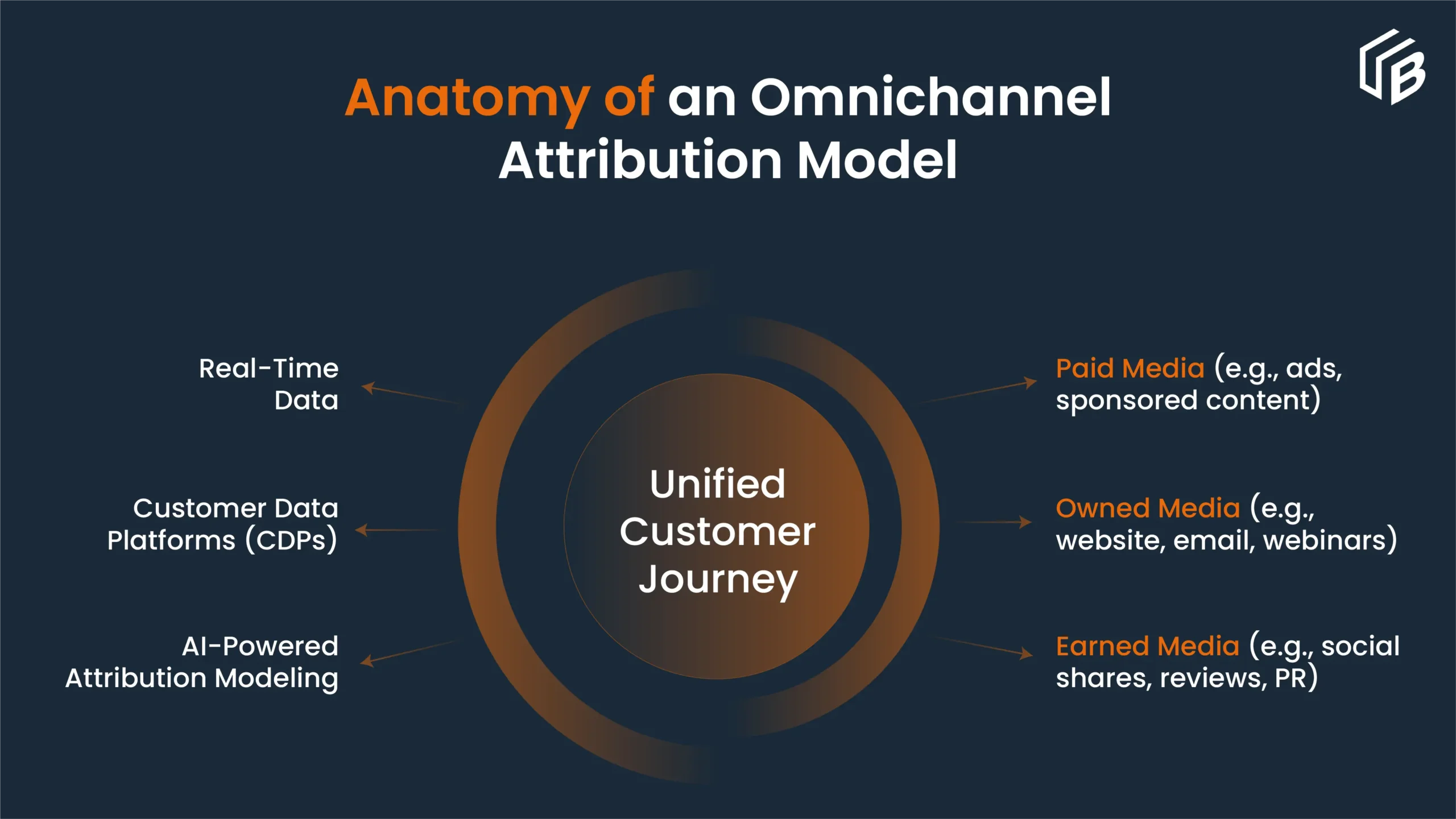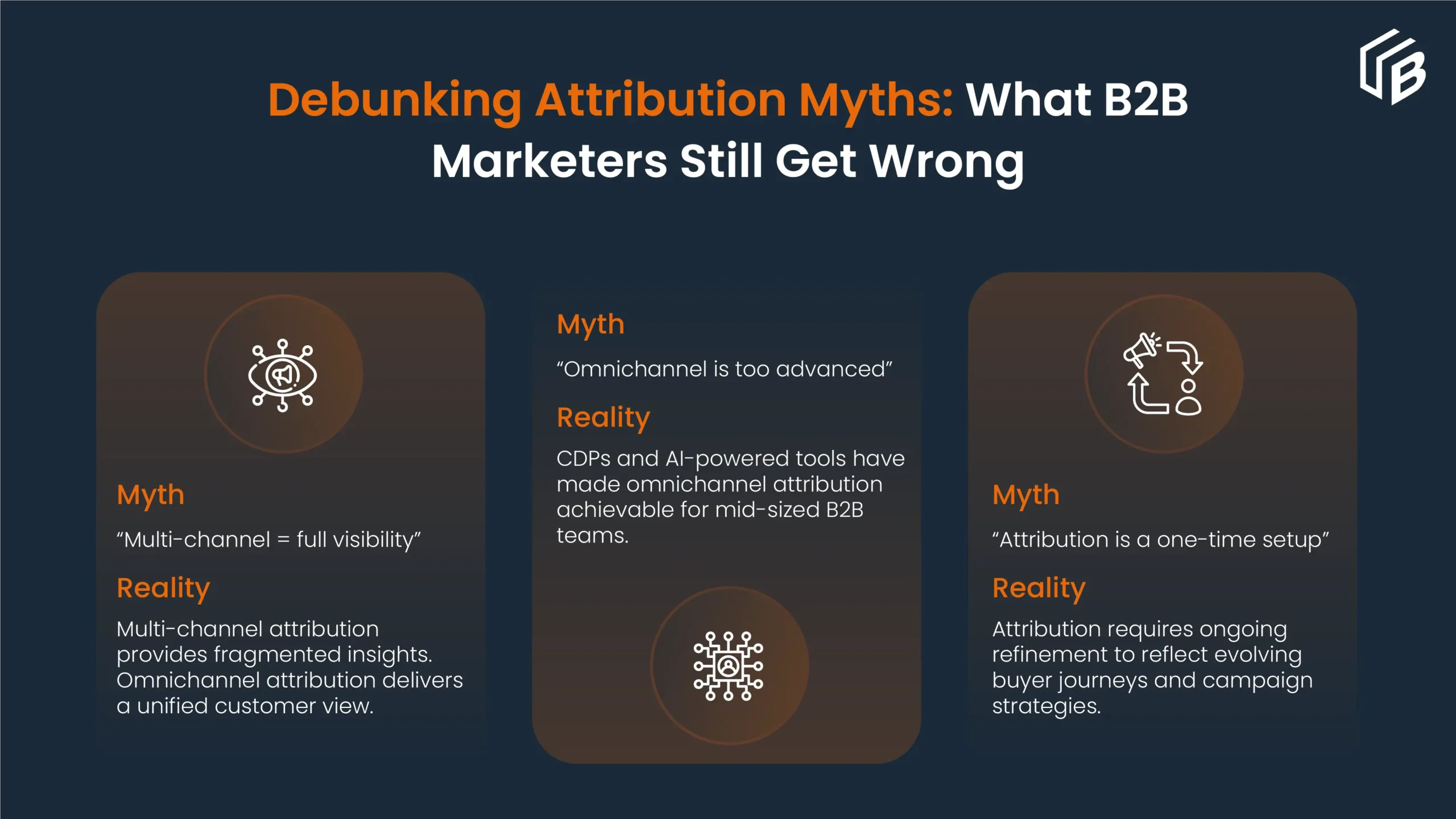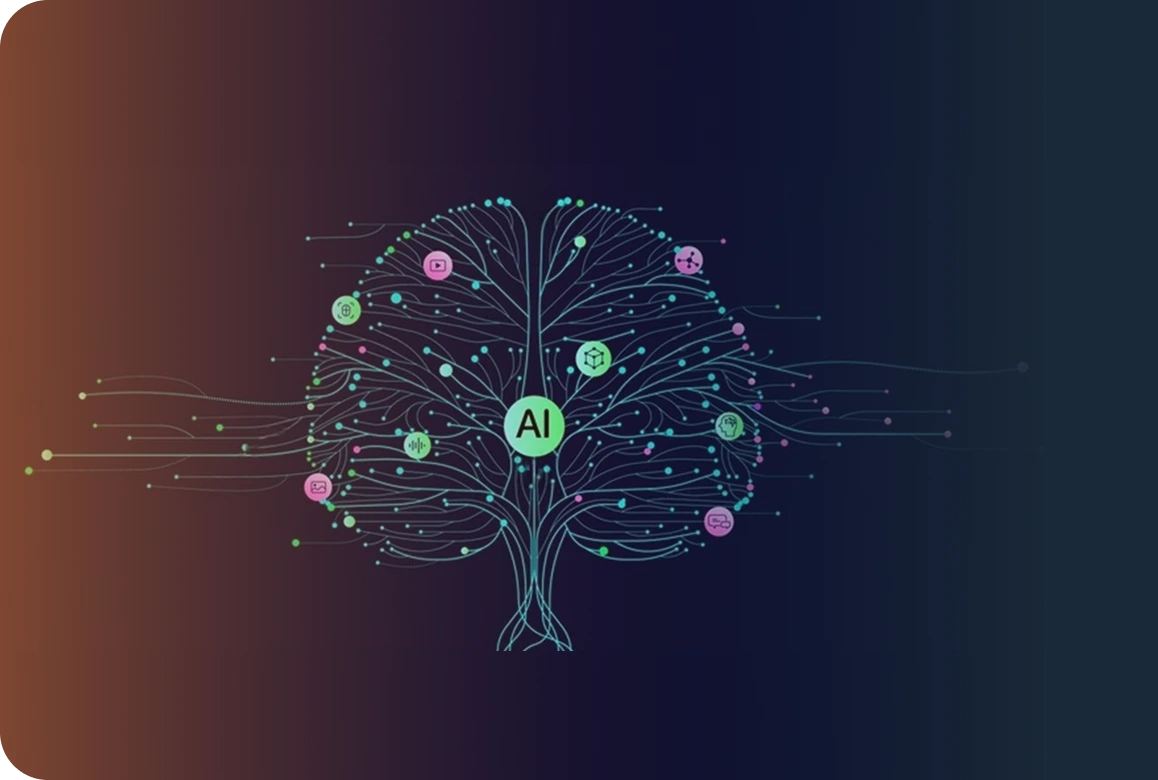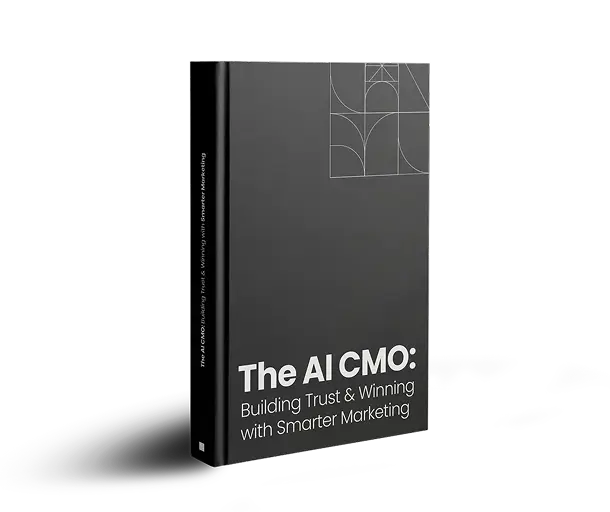
Attribution is one of the most critical and most misunderstood pillars of modern B2B marketing. With today’s B2B buyers engaging across a wide range of digital and offline touchpoints, marketing attribution has become increasingly complex. The B2B journey often spans months and involves multiple stakeholders, making it difficult to accurately track and credit the influence of each interaction.
In this fragmented environment, understanding what’s truly driving conversions, pipeline velocity, and revenue growth is essential for optimizing performance and justifying marketing spend.
Ultimately, attribution modeling is essential for performance tracking, ROI analysis, and long-term marketing effectiveness. It ensures that B2B marketing teams can justify investment, prioritize high-impact activities, and continuously refine their go-to-market strategy based on real insights.
This debate around Omnichannel vs. Multi-Channel Attribution becomes increasingly relevant. B2B marketers want to know: which model delivers more accurate insights, greater ROI clarity, and stronger strategic direction?
What Is Multi-Channel Attribution?
It is the practice of assigning credit to marketing efforts across different, often siloed, channels. The purpose of MTA is to understand how various touchpoints collectively influence a conversion, offering a more nuanced picture than single-touch models.
Common Types of Multi-Channel Attribution:
- First-Touch Attribution – This model assigns 100% credit to the first interaction.
- Last-Touch Attribution – Gives full credit to the final touchpoint.
- Linear Attribution – Distributes credit equally across all interactions.
- Time Decay Attribution – Gives more weight to recent touchpoints.
- U-Shaped/W-Shaped Attribution – Prioritizes early and mid-funnel touches while still acknowledging others.
These multi-channel attributions are useful but often fall short in mapping the intricate decision-making web typical of B2B buyers. They tend to struggle in environments where marketing and sales channels are siloed, creating data blind spots.
Additionally, the MTA model of advertising is frequently used to optimize media spend across paid channels. However, its effectiveness depends heavily on clean, centralized data and proper channel integration.
What Is Omnichannel Attribution?
Omnichannel attribution goes beyond the channel-specific approach of multi-channel models by focusing on delivering a unified view of the entire customer journey. It integrates data from paid, owned, and earned media to show how all interactions, instead of channel, work together to influence buying decisions.
Centralized, real-time data powers the omnichannel attribution model. Customer data platforms (CDPs) typically make this possible by gathering and consolidating behavioral, transactional, and engagement data from multiple sources. CDPs enable marketers to track and analyze individual-level interactions to improve attribution accuracy and targeting.

As a result, marketers gain a unified, real-time view of buyer behavior. This enables B2B marketers to attribute impact more accurately, personalize outreach, and optimize strategies with enhanced accuracy. A cohesive understanding of performance across all channels helps in data-driven decisions, especially in long, complex B2B sales cycles.
Key Differences: Omnichannel vs. Multi-Channel Attribution
When comparing omnichannel vs. multi-channel attribution, the distinction lies not just in how many channels are analyzed, but in how deeply they are connected and interpreted. Below is a breakdown of the core differences across critical dimensions:
| Feature | Omnichannel Attribution | Multi-Channel Attribution |
| Data Integration | Fully unified through centralized systems like customer data platforms (CDPs) | Often siloed or loosely connected across platforms |
| Channel Unification | Connects all touchpoints into a single, continuous experience | Views channels in isolation, limiting cross-channel insights |
| Customer Journey Insights | Provides real-time, persona-level mapping of the full journey | Offers basic funnel or path analysis |
| Scalability and Complexity | Requires deeper integration and operational maturity | Easier and quicker to implement with minimal infrastructure |
| AI-Powered Attribution Modeling | Commonly embedded in advanced platforms for dynamic, data-driven attribution | rarely used, often limited to rules-based models |
What It Means for B2B Marketers
When we discuss omnichannel and multi-channel attribution, the omnichannel approach clearly delivers more precision, especially in long, multi-touch B2B sales cycles. It supports real-time decision-making, campaign optimization, and buyer personalization at scale.
However, this doesn’t mean multi-channel attribution (MTA) is outdated or irrelevant. For many B2B organizations still building out their martech stack, MTA offers a practical starting point. It enables essential performance tracking, validates channel contributions, and supports early-stage ROI analysis without requiring significant data unification efforts.
Common Misconceptions in B2B Attribution:

Ultimately, choosing between these models isn’t about right or wrong, it’s about matching the model to your organization’s readiness, resources, and revenue goals.
AI-Powered Attribution Modeling: A New Frontier in B2B Marketing
AI-powered attribution modeling is redefining how B2B marketers evaluate campaign effectiveness. It allows marketers to assign credit dynamically based on predictive behavior patterns, engagement depth, and real-time inputs.
AI enhances accuracy by:
- Dynamically weighting touch points across campaigns.
- Predicting high-conversion paths using historical and real-time data.
- Adapting models based on channel performance trends.
Leading tools like Google Analytics 4, Adobe Experience Platform, now embed AI into their attribution frameworks. This is especially valuable in long, non-linear B2B sales cycles, where buyers may engage with your brand over several months and involve multiple stakeholders.
How to Choose the Right Attribution Model for Your B2B Business
Choosing between omnichannel vs. multi-channel attribution depends on your organization’s current capabilities, martech stack, and strategic priorities. The right approach should align with your level of data integration, team readiness, and the complexity of your customer journey.
1. Marketing Maturity
Evaluate your team’s readiness to manage sophisticated attribution strategies.
- Do you have internal alignment between marketing, sales, and operations?
- Are you already running coordinated campaigns across multiple platforms? Organizations early in their journey may benefit more from multi-channel attribution as a foundational step.
2. Data Availability and Integration
Effective attribution depends on data quality and access.
- Are your CRM, marketing automation, web analytics, and ad platforms integrated?
- Do you use a customer data platform (CDP) to unify customer interactions in real-time? Omnichannel attribution models require a centralized, clean, and connected data environment.
3. Sales Cycle Complexity
Longer, multi-touch B2B sales cycles demand deeper visibility.
- If your sales process involves multiple decision-makers and extends over several weeks or months, a basic attribution model will fail to provide a comprehensive view.
- Omnichannel attribution provides a more granular view of engagement across touchpoints and personas.
4. Budget and Resources
Your resource availability will influence implementation.
- MTA is generally easier and more cost-effective to launch, especially for mid-sized teams.
- Omnichannel attribution, while more powerful, typically requires additional investment in tools, integration, and talent.
Recommended Use Cases
- If your organization is just beginning to build its attribution framework and does not yet have unified, real-time data, start with a multi-channel attribution approach. This method helps you establish baseline performance insights and understand which channels are driving the most impact.
- As your systems become more integrated and your need for scalable insights grows, across campaigns, departments, and customer touchpoints, consider transitioning to an omnichannel attribution model. This evolution becomes especially valuable when marketing and sales teams need to align closely to drive revenue and deliver a seamless customer experience.
Strategic Questions to Ask Before You Decide
- What are the key metrics I need to optimize: pipeline velocity, lead quality, channel ROI?
- How unified and accessible is my marketing and sales data?
- Do I need real-time attribution to support dynamic decision-making, or is historical analysis sufficient for my current needs?
The right attribution model should reflect both where your organization is today and where you plan to go. Whether you begin with MTA or leap into omnichannel, the goal is to build an attribution strategy that grows with your business.
Final Thoughts: Building an Attribution Strategy for Long-Term Growth
Your B2B attribution strategy should reflect your current capabilities while laying the foundation for scalable, future growth. The MTA model offers immediate value for tracking campaign-level ROI, but omnichannel attribution provides a more advanced, integrated view of buyer behavior.
Rather than viewing omnichannel vs. multi-channel attribution as a binary choice, select the model that fits your stage and infrastructure. Start with what’s feasible, but build toward omnichannel as your data systems and strategic needs evolve. A flexible, insight-driven attribution strategy is key to driving sustained marketing performance.
FAQs
1. What is Multi-Channel CRM?
Multi-Channel CRM manages customer interactions across multiple, separate channels like email, phone, and social media, without necessarily unifying the experience.
2. What is an Example of Multi-Channel attribution?
A linear attribution model that equally credits a webinar, email campaign, and LinkedIn ad for a single lead conversion is an example of multichannel attribution.
3. What is an Omnichannel Content Strategy?
An omnichannel content strategy delivers consistent, personalized messaging across all channels, ensuring a seamless customer experience at every touchpoint.
4. What are the 4 C’s of Omnichannel?
The 4 C’s are Consistency, Context, Convenience, and Customer-centricity, which are the key principles for delivering a unified omnichannel experience.
Our blog
Latest blog posts
Tool and strategies modern teams need to help their companies grow.

Learn how to improve lead quality and boost conversion rates in B2B with AI enrichmen...

Unlock the Top 5 templates to boost your go-to-market strategy in 2025–2026 with AI...

Explore the differences between direct and programmatic ads, their trade-offs, when t...





